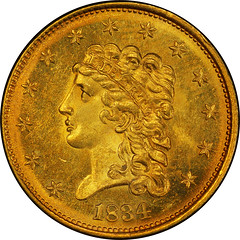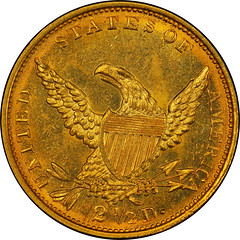
PREV ARTICLE
NEXT ARTICLE
FULL ISSUE
PREV FULL ISSUE
BOOK REVIEW: U.S. CLASSIC GOLD COINS OF 1834-1839Jim Dixon kindly submitted this review of Daryl Haynor's new book on Classic Gold. Thanks! -Editor
Dr. John W McCloskey was the primary researcher in this field but the only published work I was able to find was his essay entitled "A Study of Classic Half Eagles, 1834-1839" which was included in "America's Gold Coinage" edited by William E. Metcalf in 1989. For quarter eagles, the only serious work I was able to locate is a Heritage Auctions blog by Mark Borckardt, "Classic Head Quarter Eagles":
This fundamental lack of information regarding Classic Gold coins has been rectified by Daryl Haynor's new book entitled "United States Classic Gold Coins of 1834-1839". It is a delicious numismatic cocktail of two parts history and economics, one part early eighteen century politics and three parts coin descriptions, images and statistics. This 368 page book is perfect for numismatists who are looking for the ultimate reference on Classic Head gold coinage. This reference is so exhaustive that Mr. Haynor includes a section on "How to use this book" prior to Chapter 1. In this section he defines die marriages, die states, explains how he estimated populations, defines the rarity scale he uses in the book (a modified Overton scale) and then discusses his processes for determining finest known coins for a given year and mint. I found this section indispensable as I read through the descriptions of individual die marriages. I especially liked the methodology Mr. Haynor utilized for identifying reverses. Dr. McCloskey used letters to describe unique reverse dies for a given year but started his sequence anew each year. As a result, it was difficult to determine if a reverse die was used in subsequent years. Mr. Haynor has also used letters to identify reverse dies but has maintained the uniqueness of reverse dies throughout each series so the use of dies in multiple years is identified. In doing so, Mr. Haynor has replaced the McCloskey nomenclature for defining Classic Gold die marriages with the more precise HM (Haynor-McCloskey) identifications that are now being used by the major auction houses and are attributable as varieties at both PCGS and NGC. Chapters One through Nine are a fascinating look at the economics, politics, and personalities of the 1830's. Even if you do not collect coins, these sections represent of the best reflection I have read of these turbulent times. Unlike many other books, the references are not to other coin books but to the original 19th century documents. Mr Haynor obviously performed a great deal of original research at the Mint, the Library of Congress, the National Archives, etc. and shared images of many original documents. Chapter Ten, "Die Identification" provides very detailed definitions of the terms that Mr. Haynor uses in subsequent chapters on quarter eagles and half eagles. This information is important for Classic Gold because the dies were hand punched. Chapter Eleven contains information on the 28 die marriages of quarter eagles. It begins with mintage statistics and images that are valuable in the discussion of individual die pairings that follow. For each year, there is a short discussion about the history, politics, economics, and/or personalities relevant to that year. This is followed by:



Once the individual die marriages are described, the total known, distribution by grade and finest known coins for that year/mint are discussed. Following the analysis of the circulation strikes, a section outlining the proof coins (if any) for the year begins. In these sections, Mr. Haynor again demonstrates his expertise doing independent research regarding these proofs. History and politics are highlighted for these exceedingly rare coins. Chapter Twelve is like Chapter Eleven but addresses half eagles and includes information on the 34 unique die marriages. John McCloskey wrote about the half eagle series in his 1989 essay. As you would expect with Mr. Haynor's in depth research, a great deal of context/color is added to the pioneering work done by Dr. McCloskey. For data geeks like me, the Appendices are the cherry on top of the ice cream sundae I just devoured!
The book ends with a very touching tribute to John McCloskey written by his wife and Bradley Karoleff. In summary, this book is, and will remain, the ultimate reference for Classic Gold Coins and the history of economics, politics, and personalities in the 1830s. I highly recommend it for numismatists and history buffs alike. Jim Dixon is a dated gold collector who recently began collecting Classic Gold Half Eagles. His enthusiasm for the series increased dramatically after receiving reference information from the author.
To read the earlier E-Sylum article, see:
For more information, or to purchase the book, see:

Wayne Homren, Editor The Numismatic Bibliomania Society is a non-profit organization promoting numismatic literature. See our web site at coinbooks.org. To submit items for publication in The E-Sylum, write to the Editor at this address: whomren@gmail.com To subscribe go to: https://my.binhost.com/lists/listinfo/esylum All Rights Reserved. NBS Home Page Contact the NBS webmaster 
|
